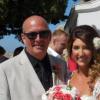
Posted
Hi everyone, I'm a beginner with Synfire and I'm just using the demo at the moment, trying to get an understanding of the software before I commit to my (inevitable) purchase!
I have lots of questions but I thought I would start bit by bit and post things here as and when I get stuck. I've sent a few emails to Andre and he's been very helpful but I don't want to keep bothering him directly. Although I'm very impressed with the service, wouldn't get that sort of attention from Steinberg for example!
A bit of background about myself. I'm a hobbyist, I write songs for my own pleasure and love doing it. I have a few completed songs but I have many brilliant ones that are all in my head! I play rhythm guitar and have a basic understanding of music theory.
I'm reading through the manual and learning bit-by-bit, I'm currently on page 89 and learning all the time.
My first question about Synfire is as follows:
I discovered the Scaleboard today so I thought I would experiment. I typed in a C major chord and then some steps (starting from 0) on the Scaleboard. The result (I think) is that all the notes played back are C, E, G and A. I get that C E G form the chord, but why the A and what about any other notes in the scale? It changes slightly depending on horizontal, vertical, bass, etc. but I can't figure out how to select a particular scale.
Also, what if I want a D to be in the melody (for example) aside from selecting 'absolute pitch'? I'm trying to work out how the figure is compiled by using a very simple example in C Major so if anyone could help, that would be great. I think once I get this basic understanding it would help me a great deal.
Additionally, when working in this way. I can't seem to apply settings to the Take. Is that because it's not a take and it was effectively typed in?
One more thing for now: When I've imported a MIDI file, I can't work out how it was interpreted. If I go to the settings and click 'Apply' without changing any settings, the Figure is re-interpreted. How do you know what settings were applied for the original interpretation?
Sorry if these questions are a bit basic, I should probably read on through the rest of the manual first, but I want to get a basic understanding as quickly as possible.
If anyone could help it would be very much appreciated.
Thank you,
Peter
Tue, 2012-12-04 - 00:43 Permalink
Yes you should read the manual - a few times and then look at lot posts here. you'll probably find the answer you seek.
This is a great but extremely complicated piece of software. No offense, but if you can't bother to read the manual, a brief explanation, will be of little value till you gain at least a beginner's grasp of Synfire.
Use the Search command on the online manual...
In answer to your second question.. After you import a midi file select one of the instruments. to the right select a Preset to use.. Best to use the preset SFP supplies first, later on you can start to play with parameters.. Use static pitches on tracks that you do not want to have interpreted.
Depending on the midi file, some will intrepret fairly closely, others will be off.. You have to fine tune, by selecting the right chord for that section, or using static import (but that limits you in other ways)
Tue, 2012-12-04 - 00:56 Permalink
I discovered the Scaleboard today so I thought I would experiment. I typed in a C major chord and then some steps (starting from 0) on the Scaleboard. The result (I think) is that all the notes played back are C, E, G and A. I get that C E G form the chord, but why the A and what about any other notes in the scale? It changes slightly depending on horizontal, vertical, bass, etc. but I can't figure out how to select a particular scale.
The numbers at the scaleboard are only related to the horizontal lines of the phrase editor, i.e 0=center line, 1=one line above (or below) and so on. They are not directly related to a scale, since Synfire works with different scales for the different Symbol types. So, the lines have different meanings, depending on the various types of symbols.
For the purple symbols (Arpeggio type) for example the center line denotes the root of the current chord and the other lines are assigned to the other notes of that chord. For the blue symbols however, the center line denotes the root of the horizontal scale and the other lines are mapped to the current horizontal scale. The details are decribed in the manual (Concept >> Figures >> Symbol Types).
Additionally, when working in this way. I can't seem to apply settings to the Take. Is that because it's not a take and it was effectively typed in?
Yes, what you have typed in are Figures, it's not a Take. A Take is the Midi data imported from a Midi file or played on a keyboard and the settings at the Take's parameter inspector control the way a Take is converted into a Figure.
One more thing for now: When I've imported a MIDI file, I can't work out how it was interpreted. If I go to the settings and click 'Apply' without changing any settings, the Figure is re-interpreted. How do you know what settings were applied for the original interpretation?
At the MIDI import you have the same setting options for the figure recognition as at the parameter inspector of the Parameter "Take". Using the same settings at the import window and at the parameter inspector should give the same results. With the parameter inspector of the parameter 'Take' you can try out the various recognition algorithms if you are not satisfied with the recognition results from the Midi import.
Tue, 2012-12-04 - 11:24 Permalink
At the MIDI import you have the same setting options for the figure recognition as at the parameter inspector of the Parameter "Take". Using the same settings at the import window and at the parameter inspector should give the same results. With the parameter inspector of the parameter 'Take' you can try out the various recognition algorithms if you are not satisfied with the recognition results from the Midi import.
Also possible to bypass the midi import by unticking the sequenze processing parameter tickbox for Create Figures when you are in the import screen.
On this way you can do figure recognition for one track only on the parameter inspector with the parameter Take
So all tracks are imported without figure recognition and in "take" parameter you can do the figure recognition for all tracks seperately.
Tue, 2012-12-04 - 12:28 Permalink
Thanks for your help guys, it makes a lot more sense now.
Mark, I didn't say I can't be bothered to read the manual, I said I am reading through the manual and have got to page 89. If I get stuck on something that I don't understand, I thought it would be a good idea to post the question on here. It may also help other new users at the same time.



